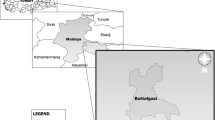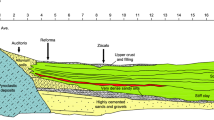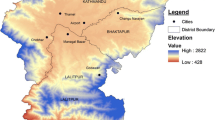Abstract
The site response analysis of Kashmir valley during the 8 October 2005 Kashmir earthquake (Mw 7.6) using the standard penetration test ‘N value’ (SPT N) geotechnical dataset is presented. Due to non-availability of the strong motion data records, synthetic ground motions at the bedrock level were generated at each borehole location by the stochastic finite fault method. The soil type-specific relationships between SPT N value and shear wave velocity were used to generate shear wave velocity profiles at each borehole site, which were later interpolated to map the shear wave velocity pattern in the Kashmir valley. The analyses revealed that site classes C and D of the NEHRP classification are dominant in the valley. The site response analysis conducted using the equivalent linear approach with DEEPSOIL showed that the local site conditions play an important role in the transmission of ground motion from the bedrock to the surface in the Kashmir valley, suggesting that it is imperative to consider the site effect in the seismic hazard assessment of the Kashmir valley. A detailed analysis of four important localities of Kashmir valley, namely, Anantnag, Baramulla, Kupwara and Srinagar, was also performed.














Similar content being viewed by others
References
Ahmad S, Bhat MI, Madden C, Bali BS (2014) Geomorphic analysis reveals active tectonic deformation on the eastern flank of the Pir Panjal range, Kashmir Valley, India. Arab J Geosci 7(6):2225–2235
Ambraseys N, Douglas J (2004) Magnitude calibration of north Indian earthquakes. Geophys J Int 159:165–206
Anderson J, Hough S (1984) A model for the shape of the Fourier amplitude spectrum of acceleration at high frequencies. Bull Seismol Soc Am 74:1969–1993
Avouac JP, Ayoub F, Leprince S, Konca O, Helmberger DV (2006) The 2005, Mw 7.6 Kashmir earthquake: sub-pixel correlation of ASTER images and seismic wave form analysis. Earth Planet Sci Lett 249:514–528
Beresnev I, Atkinson GM (1998) FINSIM: a FORTRAN program for simulating stochastic acceleration time histories from finite faults. Seismol Res Lett 69:27–32
Bindi D, Parolai S, Cara F, Giulio G, Ferretti G, Luzi L, Monachesi G, Pacor F, Rovelli A (2009) Site amplifications observed in the Gubbio Basin, Central Italy: hints for lateral Propagation effects. Bull Seismol Soc Am 99:741–760
Bhatt DK (1989) Lithostratigraphy of Karewa group, Kashmir valley, India and a critical review of its fossil record. Mem Geol Surv India 122:3–9
Burbank DW (1983) The chronology of Intermontane-basin development in the northwestern Himalaya and the evolution of the northwest Syntaxis. Earth Planet Sci Lett 64:77–92
Burbank DW, Johnson GD (1982) Intermontane-basin development in the past 4 My in the north-west Himalaya. Nature 298:432–436
Burbank DW, Johnson GD (1983) The late Cenozoic chronologic and stratigraphic development of the Kashmir Intermontane basin, northwestern Himalaya. Palaeogeography Palaeoclimatology Paleoecology 43:205–235
Bureau of Indian Standards (1997) IS 2131-1981. Standard penetration test. Bureau of Indian Standards, New Delhi
Castelli F, Cavallaro A, Grasso S, Lentini V (2016) Seismic microzoning from synthetic ground motion earthquake scenarios parameters: the case study of the City of Catania (Italy). Soil Dyn Earthq Eng 88:307–327
Christenson GE (1994) Ground shaking in Utah (Public Information Series/Utah Geological Survey). Utah Geol Surv 29:1–4
Dasgupta S, Pande P, Ganguly D, Iqbal Z, Sanyal K, Venaktraman NV, Dasgupta S, Sural B, Harendranath L, Mazumdar K, Sanyal S, Roy A, Das LK, Misra PS, Gupta H (2000) Seismotectonic atlas of India and its environs. Geol Surv India Spec Publ 59:87
Ferraro A, Grasso S, Maugeri M, Totani F (2016) Seismic response analysis in the southern part of the historic centre of the City of L’Aquila (Italy). Soil Dyn Earthq Eng 88:256–264
Hashash YMA, Musgrove MI, Harmon JA, Groholski DR, Phillips CA, Park D (2016) “DEEPSOIL 6.1, user manual”. http://deepsoil.cee.illinois.edu/Files/DEEPSOIL_User_Manual_v6.pdf
Kazmi AH, Jan MQ (1973) Geology and tectonics of Pakistan. Graphic Publishers, Karachi Pakistan, pp.545
Kramer SL (1997) Geotechnical earthquake engineering. Prentice Hall, Upper Saddle River
Laoumani N, Slimani A (2013) Earthquake induced site effects in the Algiers-Boumerdes region: relation between spectral ratios higher peaks and observed damage during the may 21st mw 6.8 Boumerdes earthquake (Algeria). Pure Appl Geophys 170:1785–1801
Mandal P, Chadha RK, Kumar N, Raju IP, Satyamurty C (2007) Source parameters of the deadly Mw 7.6 Kashmir earthquake of 8 October, 2005. Pure Appl Geophys 164(10):1963–1983
Ministry of Earth Sciences (2011) Seismic microzonation handbook. Ministry of Earth Sciences, Government of India, New Delhi
Motezedin D, Atkinson GM (2005) Stochastic finite-fault modeling based on a dynamic corner frequency. Bull Seismol Soc Am 95(3):995–1010
Ordaz M, Faccioli E (1994) Site response analysis in the valley of Mexico: selection of input motion and extent of non-linear soil behavior. Earthq Eng Struct Dynamics 23:895–908. https://doi.org/10.1002/eqe.4290230806
Raghukanth STG (2008) Ground motion estimation during the Kashmir earthquake of 8th October 2005. Nat Hazards 46(1):1–13
Sana H (2017). Synthetic ground motions of the 8 October 2005 Kashmir earthquake (Mw 7.6): a stochastic finite fault element approach. Southern California Earthquake Center Annual Meeting, 2017. Proceedings Volume XXVII, September 9-13, 2017. Poster Number 252
Sana H, Nath SK (2016) Liquefaction potential analysis of the Kashmir valley alluvium, NW Himalaya. Soil Dynamics Earthq Eng 85:11–18
Singh SK, Mena E, Castro R (1988) Some aspects of source characteristics of the 19 September 1985 Michoacan earthquake and ground motion amplification in and near Mexico City from strong motion data. Bull Seismol Soc Am 78:451–477
Singh SK, Iglesias A, Dattatrayam RS, Bansal BK, Rais SS, Perez-Campos X, Suresh G, Baidya PR, Gautam JL (2006) Muzaffarabad earthquake of 8 October 2005 (Mw 7.6): A preliminary report on source characteristics and recorded ground motions. Curr Sci 91(5):689–695
Steidl J (2000) Site response in Southern California for probabilistic seismic hazard analysis. Bull Seismol Soc Am 90(6B):S149–S169
Acknowledgements
We thank Space Engineers Pvt. Limited, Ajaz Masood, Quality Control Laboratory JKPCC and Structural Consultants for providing the SPT N value borehole data across the valley. The first author is also grateful to the Universty Grants Commision for a CSIR-UGC (NET) JRF fellowship and to the Long Term Conceptual Development Research Organization for a grant (Grant No: RVO: 67985891, IRSM, CAS, Czech Republic). All authors thank the reviewers for their comments and suggestions, which improved the quality of this manuscript.
Author information
Authors and Affiliations
Corresponding author
Rights and permissions
About this article
Cite this article
Sana, H., Nath, S. . & Gujral, K.S. Site response analysis of the Kashmir valley during the 8 October 2005 Kashmir earthquake (Mw 7.6) using a geotechnical dataset. Bull Eng Geol Environ 78, 2551–2563 (2019). https://doi.org/10.1007/s10064-018-1254-1
Received:
Accepted:
Published:
Issue Date:
DOI: https://doi.org/10.1007/s10064-018-1254-1




